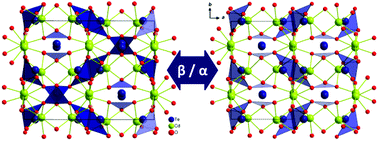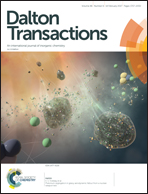A new β-CdTeO3 polymorph with a structure related to α-CdTeO3†
Abstract
A new β-CdTeO3 polymorph was obtained by hydrothermal synthesis and its structure was solved ab initio from powder X-ray diffraction data. It appears that the structure of β-CdTeO3 (Pnma, Z = 16, a = 7.45850(3) Å, b = 14.52185(6) Å, c = 11.04584(5) Å) is closely related to that of α-CdTeO3 (P21/c, Z = 8, a = 7.790(1) Å, b = 11.253(2) Å, c = 7.418(1) Å, β = 113.5(1)°) previously reported. The 3D framework of β-CdTeO3 is built of both [CdO6] distorted octahedra and [CdO7] mono-capped trigonal prisms and three different tellurium polyhedra: trigonal pyramids [TeIVO3E] and trigonal bipyramids [TeIVO4E] and [TeIVO3+1E] (E denotes the lone pair of TeIV). The electronic structure calculations based on density functional theory methods show that at the ground state α-CdTeO3 is slightly more stable than β-CdTeO3 with an energy difference of 4.64 kJ mol−1. The band structures confirm the results of optical UV-Vis spectroscopy measurements: both polymorphs are wide bandgap semiconductors with Eg = 3.55 eV for β-CdTeO3 and Eg = 3.91 eV for α-CdTeO3. The DOS calculations for both polymorphs enable one to understand that the presence of the [TeIVO4E] polyhedra in β-CdTeO3 (absent in α-CdTeO3) lowers its bandgap. Above 540 °C β-CdTeO3 transforms into α-CdTeO3 in a first order phase transition.



 Please wait while we load your content...
Please wait while we load your content...